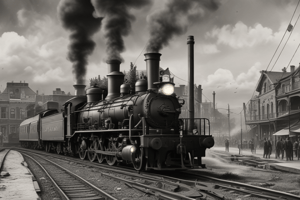Podcast
Questions and Answers
Who were the 'Titans of Industry'?
Who were the 'Titans of Industry'?
- Andrew Carnegie (correct)
- Henry Ford (correct)
- J.P. Morgan (correct)
- John D. Rockefeller (correct)
- Cornelius Vanderbilt (correct)
What characteristics make up the late 19th century in America?
What characteristics make up the late 19th century in America?
A time of great innovation, with the birth of cities and railroads, manufacturing dominance, and the establishment of trusts.
Who is John D. Rockefeller?
Who is John D. Rockefeller?
President and founder of Standard Oil.
What was the defining product of America's Industrial Revolution?
What was the defining product of America's Industrial Revolution?
What products did Standard Oil provide to consumers in the United States and to others worldwide?
What products did Standard Oil provide to consumers in the United States and to others worldwide?
How did the federal government break the stranglehold that monopolies had on fair competition in the United States?
How did the federal government break the stranglehold that monopolies had on fair competition in the United States?
Who is Ida Tarbell?
Who is Ida Tarbell?
Why was Standard Oil considered to be such a powerful trust?
Why was Standard Oil considered to be such a powerful trust?
What happened to Standard Oil following Ida Tarbell's publications about the corporation?
What happened to Standard Oil following Ida Tarbell's publications about the corporation?
Flashcards are hidden until you start studying
Study Notes
Titans of Industry
- Key figures included John D. Rockefeller, Cornelius Vanderbilt, Andrew Carnegie, Henry Ford, and J.P. Morgan.
- Established multinational corporations or trusts that significantly advanced American industry.
- Their activities contributed to the peak of economic growth during the U.S. Industrial Revolution.
Characteristics of the Late 19th Century America
- Marked by rapid innovation, urbanization, and the rise of manufacturing.
- Emergence of major corporations such as U.S. Steel and International Harvester.
- Establishment of trusts aimed at reducing competition, particularly in coal, oil, and steel industries.
- Influential bankers and business tycoons played a crucial role in shaping the economy.
John D. Rockefeller
- Founded Standard Oil, which became the most powerful trust in the U.S.
- Focused on monopolizing the oil industry, leading to significant control over pricing and supply.
Defining Product of America's Industrial Revolution
- Highlighted innovations and developments that revolutionized production processes, notably in steel and oil industries.
Standard Oil Products
- Supplied a range of petroleum products to American consumers and international markets, establishing a global presence.
Federal Government's Action Against Monopolies
- Implemented regulations and laws aimed at fostering fair competition and dismantling monopolistic practices, notably through antitrust legislation.
Ida Tarbell
- Renowned journalist and muckraker credited with a detailed, critical examination of Standard Oil through her 19-part exposé.
- Played a pivotal role in raising public awareness of corporate malfeasance during the Gilded Age.
Power of Standard Oil
- Dominated the U.S. oil industry by controlling approximately 90% of the domestic market and nearly 80% of the global supply.
- Maintained exclusive control over railway transportation for oil products, strengthening its monopoly.
Consequences of Tarbell's Expose
- Her publications heightened public scrutiny of Standard Oil, contributing to significant regulatory and societal changes.
Studying That Suits You
Use AI to generate personalized quizzes and flashcards to suit your learning preferences.




